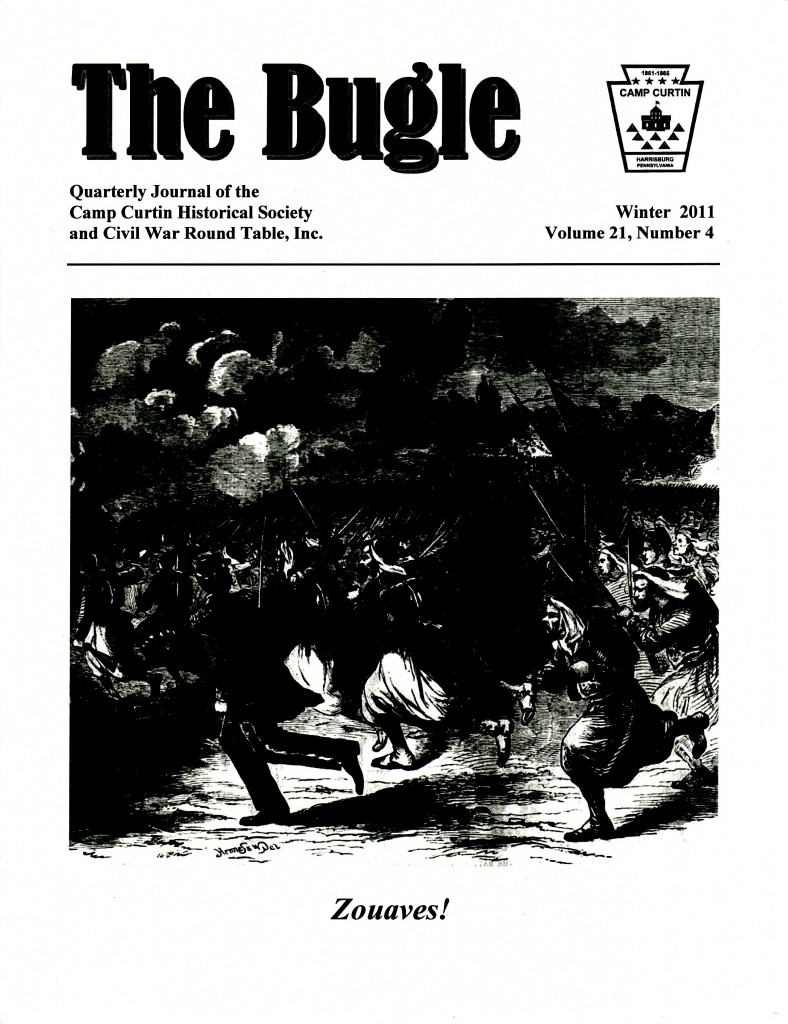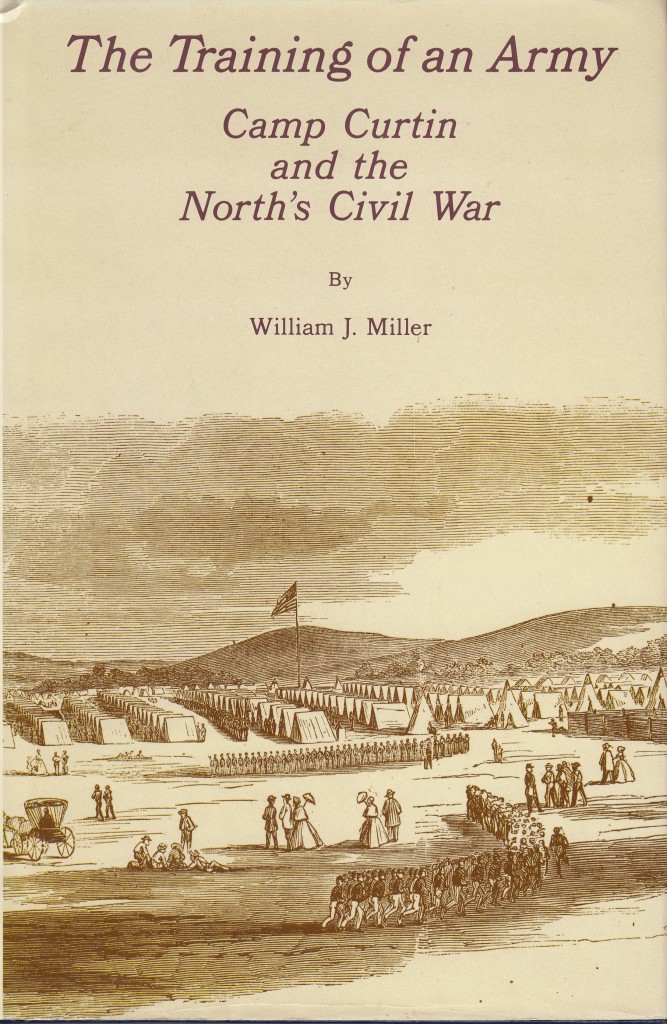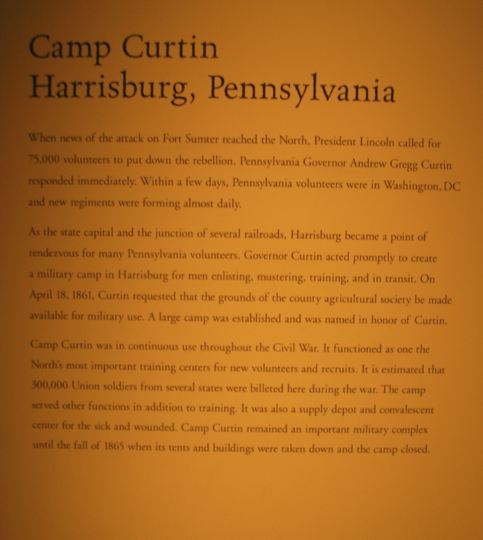Camp Curtin Historical Perspective
Posted By Norman Gasbarro on February 18, 2012
In the post yesterday, four memorials to Camp Curtin, the great Civil War army training camp in Harrisburg, were presented. Unfortunately nothing remains of the camp and it is left to research and the imagination to determine what actually happened there. It was also noted that only one photo was taken there and that photo is shown on the Harrisburg History Project Historical Marker.
Today’s post will focus on some research aids to find out more about Camp Curtain, the first of which will be the book by William J. Miller, The Training of an Army: Camp Curtin and the North’s Civil War. The book was published in 1990 by White Mane of Shippensburg, Pennsylvania, and is generally available through used book sellers or though libraries (cover pictured above)
Inside the front cover of the book is a map of Pennsylvania showing some key cities – including Pittsburgh, Harrisburg, and Philadelphia – and the rail network connecting these cities as well as Elmira, New York, and points south. This strategic importance of the city of Harrisburg as a rail center was discussed in several prior posts. The map is repeated in the “Prologue” on page xii. Also in the book is a map showing the location of Camp Curtain in Harrisburg (page 6) and a diagram of the layout of the camp (page 7). The book is illustrated with portraits of the several commanders of Camp Curtin and also contains a useful “Appendix III” listing all the Pennsylvania regiments (as well as those from other states) that encamped there during the war. Miller points out that many other regiments “passed through” or stopped at the camp only briefly, and that in compiling the list, he only included those regiments that spent at least a day and night in the camp.
There is much useful primary source material here – too much to describe in a brief review. Extensive end notes document the text. All aspects of the Camp are discussed – from its formation to use as a training camp to use as a hospital to its disbandment.
The above map of Harrisburg during the Civil War is from the Pennsylvania Archives Map Collection and has been “annotated” to show the location of Camp Curtin and the location of the Harrisburg Train Station. Note that the rail line running north and south is the Northern Central Railroad which ran roughly parallel to the camp. The camp was located approximately one mile north of the station. Soldiers arrived at the station and then marched through the city streets to the camp entrance. When it was time to go to war, soldiers marched from the camp to the train station and boarded the trains. Many trains went by the camp as they headed south or north and surely activity at the camp was seen from the trains – at the very least, noise and smoke from the fires. Nearly all the trains heading north or coming from the north passed through the Lykens Valley which was just more than 30 minutes away by rail. Station stops in Halifax, Millersburg and Herndon were on this route. Unfortunately, there are few descriptions of the effect of the troop movements to and from Camp Curtin on these Lykens Valley area towns. Also passing Camp Curtin on this route were African Americans escaping slavery and Confederate prisoners of war heading to Elmira, New York. Much research still needs to be done to uncover what was known and thought about Camp Curtin through the war years.
A resource from the Pennsylvania Archives, previously mentioned, is the Pennsylvania Veterans’ Card File. The source notes the muster location of the soldier. If the location is “Harrisburg,” the odds are that the soldier was mustered at Camp Curtin, but this conclusion is not a certainty as there were many other muster locations in and around Harrisburg. Additional delving into the regimental records as well as the “lists” of regiments that mustered or were trained at Camp Curtin is needed.
 The Bugle is the Quarterly Journal of the Camp Curtin Historical Society and Civil War Round Table. In the current issue, there is a feature on the Zouaves, who were the soldiers in “colorful uniforms.” A list of regiments that had Zouave components is included in the article. The Society meets at the Camp Curtin Memorial Mitchell United Methodist Church (see yesterday’s post). A web site is maintained at www.campcurtin.org and contact may be made through e-mail by clicking here. The postal address of the society is: P.O. Box 5601, Harrisburg, PA 17110. Finally, a revised edition of Civil War Harrisburg: A Guide to Capital Area Sites, Incidents and Personalities, is available for $13 and was previously mentioned here on this blog. There is a good amount of material on Camp Curtin in that book as well as the names of many other army camps around the Harrisburg area of which very little is known. In some cases, even the location of the camp is unknown. Research continues to re-discover many of the lost stories and artifacts of this critical time in the history of Harrisburg.
The Bugle is the Quarterly Journal of the Camp Curtin Historical Society and Civil War Round Table. In the current issue, there is a feature on the Zouaves, who were the soldiers in “colorful uniforms.” A list of regiments that had Zouave components is included in the article. The Society meets at the Camp Curtin Memorial Mitchell United Methodist Church (see yesterday’s post). A web site is maintained at www.campcurtin.org and contact may be made through e-mail by clicking here. The postal address of the society is: P.O. Box 5601, Harrisburg, PA 17110. Finally, a revised edition of Civil War Harrisburg: A Guide to Capital Area Sites, Incidents and Personalities, is available for $13 and was previously mentioned here on this blog. There is a good amount of material on Camp Curtin in that book as well as the names of many other army camps around the Harrisburg area of which very little is known. In some cases, even the location of the camp is unknown. Research continues to re-discover many of the lost stories and artifacts of this critical time in the history of Harrisburg.
The final resource to be noted is the “exhibit” about Camp Curtin at the National Civil War Museum. This is an extremely limited resource in that it occupies only a very small area of the total exhibit space. Since this “national” museum is not about telling the history of Harrisburg in the Civil War but rather the war in its entirety, the limitation is justified. However, the justification for the location of the museum in the city of Harrisburg includes the fact that Camp Curtin was located there and that would certainly merit a larger display. Essentially, what is shown at the museum is about the same as what can be seen on the memorials in the city.
 ;
;





How do I get information on dates and place?